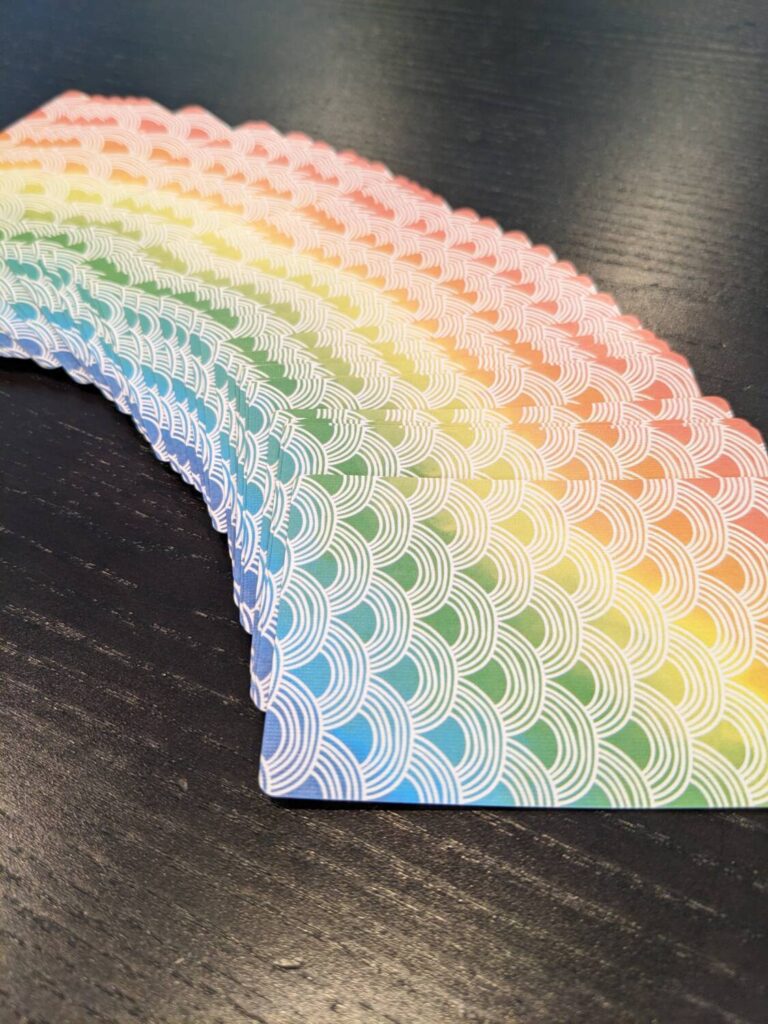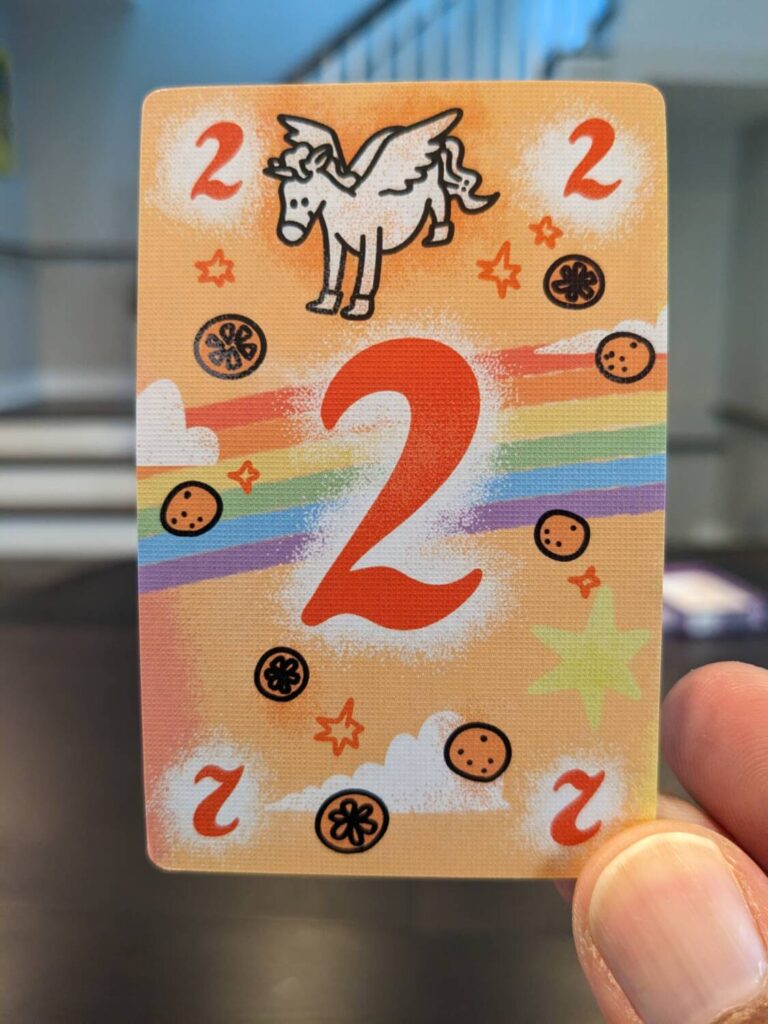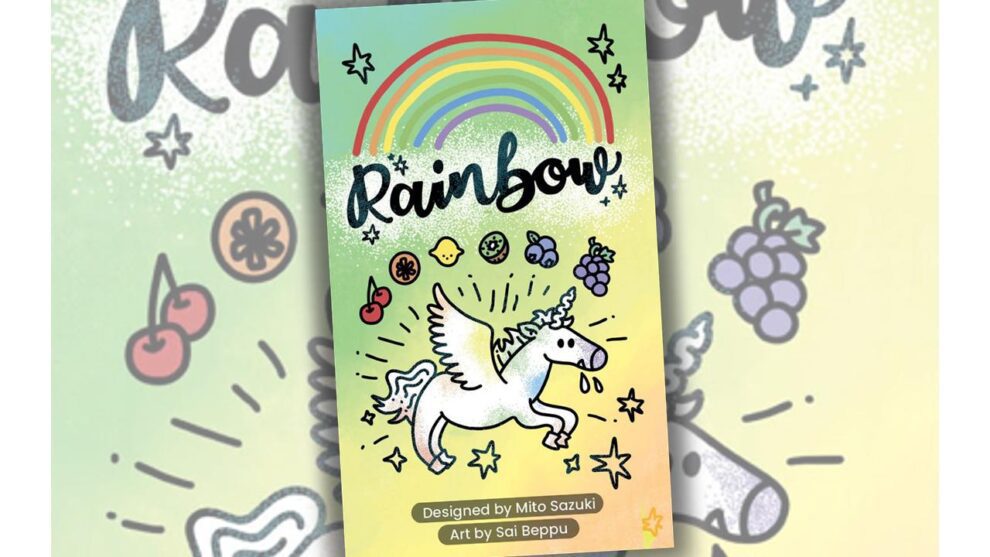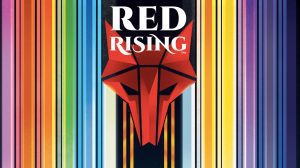Disclosure: Meeple Mountain received a free copy of this product in exchange for an honest, unbiased review. This review is not intended to be an endorsement.
Cute unicorns on the box. Colorful calligraphy. A family-weight set of rules that accommodate players aged seven and up. A playtime, including the teach, that wrapped up in less than 10 minutes for each of my three plays.
On the surface, the new trick-taking game Rainbow (2024, Allplay) looked like a silly affair. It didn’t immediately draw me in. But during my second play, a three-player game with my wife and seven-year-old son, something happened about halfway through that play.
“There’s…something here,” my wife said. I agreed. My son, who I don’t think did this intentionally on our first play, took his time playing cards on turns where he wouldn’t win many points, but played more cards on more meaningful tricks. He ended up winning that game, leaving us in his wake.
Rainbow is a trick-taker with loose rules regarding the trick’s structure…let me explain.
Each player is dealt a hand of cards (aligned with player count) from a deck featuring 60 cards, built from 10 sets of six cards numbered 1-6. In the middle of the table, there is one card face-up for each player in the game, drawn from that same shared deck. The cards in the center of the table are point cards, allotted at the end of each trick to the player who played the most cards with the highest value. (In the case of a tie, the player who went earlier in turn order.)

The lead player has a choice: play a single card, a set (a collection of an identical number, such as three 3s), or a run (1,2,3, etc.). If they play a single card, the next player can follow with a single, a set, or a run. But if anyone plays a set or a run, the next players have to follow with a matching alignment…so, if player A leads with a run of 2,3, other players have to play something “higher”—a 3,4, for example, or a 1,2,3, since that is legal and has more cards—in order to win the trick.
Once each player plays one batch of cards, the trick is over. Whoever won takes the highest point card (or pair of cards) from the center of the table, then pushes their played cards into the center. All players’ cards are sorted and built into scoring sets (one per player) that include single cards or pairs.
This led to a surprisingly meaty series of turns in our games. Some tricks had a pair of 6s in the middle of the table, suddenly making the active trick essential. In other cases, a bunch of 1s and 2s were in the middle of the table, and players were doing their best to play but not that interested in winning…until they realized that leading a trick allows a player to dictate the turn if they have something juicy in hand.
But then another consideration surfaced—I don’t want to run out of cards too early, because if I do, I can’t win any more tricks!!
Why were we asking so many questions of a game featuring a 10-minute playtime and freaking unicorns???

Yeah, There’s Something Here
Rainbow is a surprise. My kids really liked it. I really liked it. My wife hated watching our son win because she was blown off the table…but she “hated” it so much that she immediately asked to play it again, then won. She suddenly changed her tune. “Yeah, I really like Rainbow!” was the format of her second review.
Rainbow plays 2-6 players; I thought the two-player variant was not great. (I tried Rainbow at two, three, and four players.) It requires each player to play two batches per trick (separately, so Player A plays into a trick, then Player B, then A, then B), then the two players have to play a second complete set of 14 cards each, again. It runs too long and becomes a somewhat different game in this format.
But at 3+ players, Rainbow is a joy thanks to its pace and strategic depth for something that didn’t look like much when I pulled it out of the box. For a price under $10, it is hard to go wrong!











Add Comment